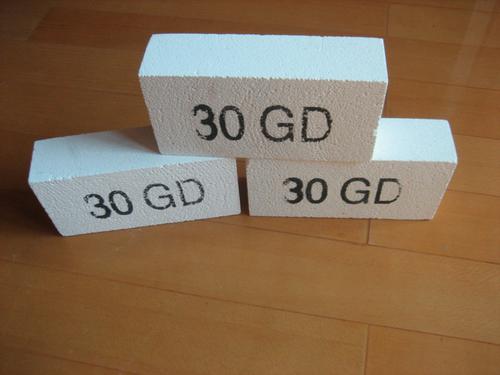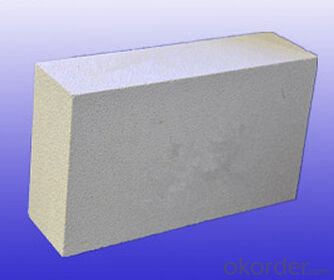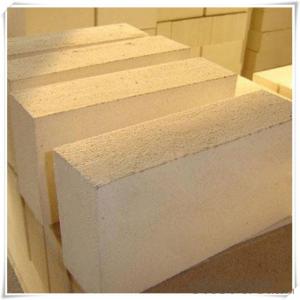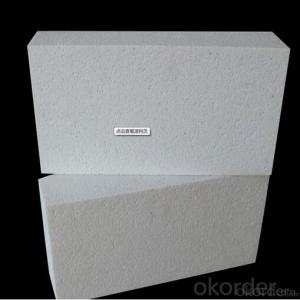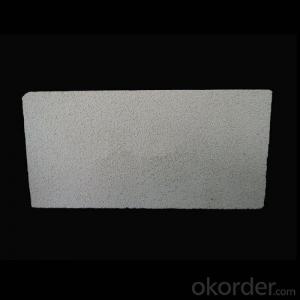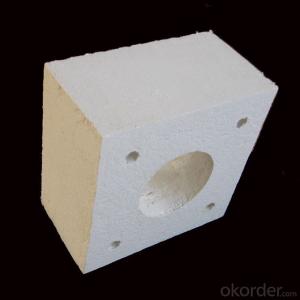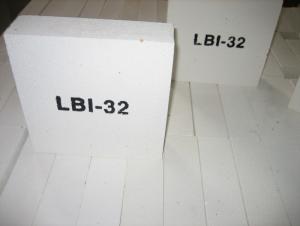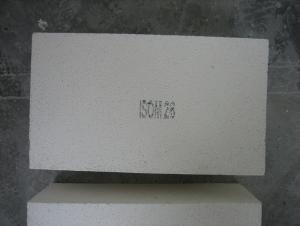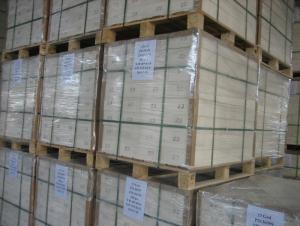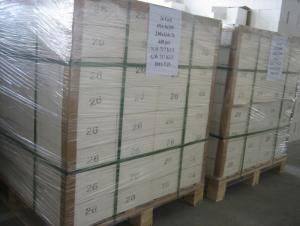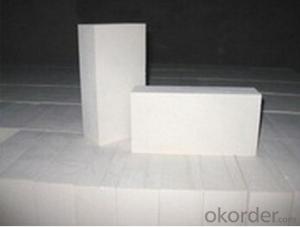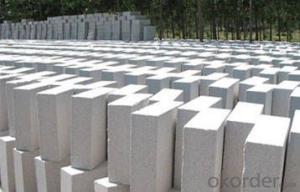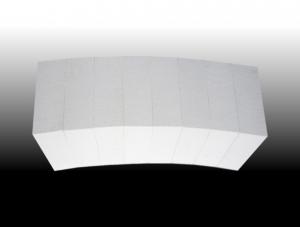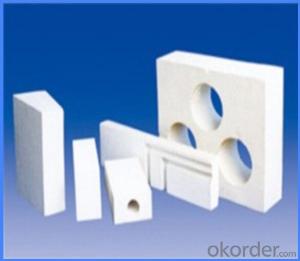Insulating Fire Brick - Refractory Mullite Insulating Refractory Brick JM 27
- Loading Port:
- Shanghai
- Payment Terms:
- TT OR LC
- Min Order Qty:
- 20 m.t.
- Supply Capability:
- 20 m.t./month
OKorder Service Pledge
OKorder Financial Service
You Might Also Like
General Information
CMAX insulating firebricks are classified under temperature between 1300℃ to 1700℃, manufactured from high purity alumina clay.
1. Lower content of iron, alkaline and impurities, good high temperature properties.
2. Homogeneous structure, light weight, energy saving because lower heat storage in the furnace during cooling cycles.
3. High strength, good thermal shock resistance under high temperature.
4. Precise sizes due to grinding and shaping after sintering, which meets the requirement of construction.
5. Max service temp: Up to 1730C (3160F)
Feature
Light weight and low thermal conductivity
Low heat storage
Low iron and impurities
High thermal shock resistance
Application of Insulating brick
Metallurgical Industry: blast furnace, hot blast furnace, heating furnace, etc..
Petrochemical Industry: ethylene cracking furnace, hydrogen furnace, the main furnace, heating furnace, etc..
Ceramic industry: roller kiln, kiln, etc..
Glass industry: glass furnace regenerator, etc.
Carbon industry: carbon furnace, etc..
Aluminum electrolysis industry: aluminum reduction cell, etc.
Other industries: tunnel kiln, shuttle kiln, etc.
Advantages of heat insulation brick
Low thermal conductivity: many air holes will bring good thermal insulation effect, energy saving.
High crushing strength: high crushing strength, volume stability.
Low heat storage: small heat storage, absorb more heat, energy-saving effect is obvious.
Technical Data
ITEM | GJM30 | GJM28 | GJM26 | GJM23 |
Classification Temperature, ℉/℃ | 3000/1650 | 2800/1540 | 2600/1430 | 2300/1260 |
Bulk Density,g/cm³ | ≤1.0 | ≤0.9 | ≤0.8 | ≥0.5 |
Reheating Linear Change, % | ≤0.9 (1550℃,12 h) | ≤0.8 (1510℃,12 h) | ≤0.7 (1410℃,12 h) | ≤0.5 (1230℃,12 h) |
Al2O3 Content, % | ≥75 | ≥65 | ≥55 | ≥45 |
Fe2O3 Content, % | ≤0.5 | ≤0.6 | ≤0.7 | ≤1.0 |
Thermal Conductivity: | ||||
800℃, w/m.k | ≤0.39 | ≤0.37 | ≤0.35 | ≤0.18 |
1000℃, w/m.k | ≤0.43 | ≤0.41 | ≤0.39 | ≤0.20 |
1200℃, w/m.k | ≤0.48 | ≤0.46 | ≤0.43 | --- |
Insulating brick
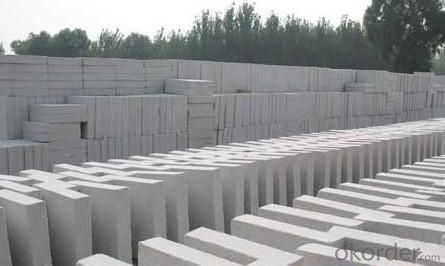
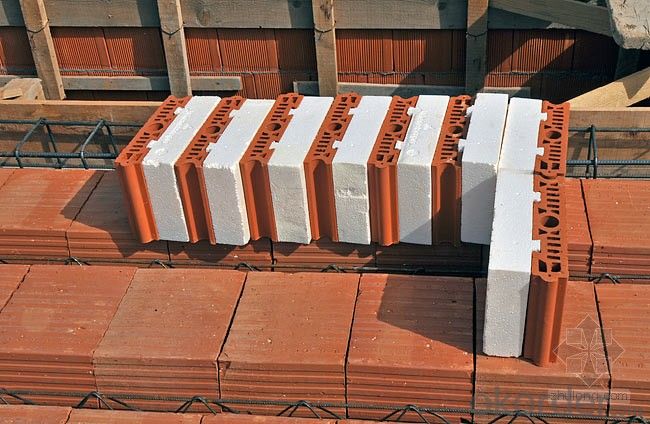
Common problem solution
1. What products do you have?
We have all kinds of refractory bricks, refractory casting materials, mortar, cement, ceramic fiber products, etc..
Or you can browse our products to choose what you need.
2. How to control product quality?
With strict quality control system throughout the material selection and production process, we have the quality of refractory materials and ceramic fiber products to meet customer requirements.
From the selection of raw materials, the quality of our control to start. The quality of the raw materials required for each batch of products in the use of the front line test. In the production process, through the quality control of workers, and then to each piece of classification, and through quality supervision and inspection.
3. Could you give me a brief introduction to the application of your product?
My Company is mainly engaged in steel, cement, glass, ceramics, petrochemical, electric power and other industries.
4. If I need you, what kind of information do you need?
In order to select the right products, we will provide us with information, such as the United States, technical data, order quantity, product applications, etc..
If you have any questions, please contact us.
- Q: How do insulating fire bricks prevent heat transfer?
- Combining both their composition and structure, insulating fire bricks prevent the transfer of heat. These bricks are crafted from specialized refractory materials, such as silica, alumina, or clay, which possess high thermal resistance. Essentially, these materials have low thermal conductivity, meaning they are not easily able to conduct heat. Moreover, insulating fire bricks are often manufactured with tiny air pockets or cells within their structure. These air pockets serve as barriers for heat transfer since air is a poor conductor of heat. Consequently, when heat is applied to one side of the brick, the refractory materials' low thermal conductivity, coupled with the presence of air pockets, collaboratively minimize the amount of heat conducted through the brick. Consequently, this effectively prevents heat from transferring from one side of the brick to the other, providing insulation and reducing energy loss.
- Q: Can insulating fire bricks be used as a lining for kiln cars?
- Yes, insulating fire bricks can be used as a lining for kiln cars. These bricks are designed to withstand high temperatures and have excellent insulating properties, making them ideal for use in kilns where heat retention is required. Additionally, their lightweight nature makes them suitable for use on kiln cars, which need to be moved frequently.
- Q: Can insulating fire bricks be used in the construction of industrial chimneys?
- Yes, insulating fire bricks can be used in the construction of industrial chimneys. These bricks have excellent thermal insulation properties, which can help in reducing heat loss and improving the overall energy efficiency of the chimney. Additionally, insulating fire bricks are lightweight and resistant to high temperatures, making them suitable for the harsh conditions often found in industrial settings.
- Q: How do insulating fire bricks perform in terms of sound insulation?
- Insulating fire bricks are primarily designed for excellent thermal insulation, but their performance in terms of sound insulation can vary. While they can provide some sound reduction due to their dense and non-porous nature, they are not specifically engineered for soundproofing. The level of sound insulation offered by insulating fire bricks depends on factors such as brick thickness, density, and sound frequency. Generally, insulating fire bricks can somewhat reduce high-frequency noises, but they may not be as effective in blocking low-frequency sounds. For superior sound insulation, specialized acoustic materials or construction techniques may be more appropriate.
- Q: Is the quality of brick made of small-sized self insulation block equipment the same as that of large block brick equipment?
- In fact, brick and tile production is only a different production, the quality of brick produced is the same, from the silver horse experience
- Q: Can insulating fire bricks be used in the construction of furnaces?
- Insulating fire bricks are indeed suitable for the construction of furnaces. These bricks possess exceptional insulation qualities, enabling them to endure high temperatures without significant heat loss. Their composition primarily consists of lightweight materials like clay, silica, and alumina. Consequently, they exhibit low thermal conductivity, allowing the furnace to retain heat efficiently while preventing excessive heating of its outer surface. As a result, these bricks are ideal for lining the walls, roof, and floor of furnaces, contributing to enhanced energy efficiency and reduced fuel consumption. Moreover, their resistance to thermal shock ensures their durability and longevity in the demanding conditions of a furnace. In conclusion, considering their exceptional insulation properties and capacity to withstand high temperatures, insulating fire bricks remain a preferred option for furnace construction.
- Q: Are insulating fire bricks resistant to fire damage?
- Insulating fire bricks have been specially crafted to endure fire damage. Their composition consists of unique refractory materials, enabling them to withstand exceedingly high temperatures without warping or compromising their insulation capabilities. Possessing a high melting point and low thermal conductivity, these bricks effectively insulate against heat transfer and safeguard against fire harm. Their utilization is widespread in scenarios demanding exposure to fire and elevated temperatures, including furnaces, kilns, fireplaces, and industrial procedures. In summary, insulating fire bricks exhibit reliability and durability, delivering exemplary defense against fire damage.
- Q: Can insulating fire bricks be used for fireplace construction?
- Indeed, insulating fire bricks are suitable for constructing fireplaces. These bricks are specifically engineered to endure extreme temperatures while offering superb insulation, rendering them perfect for lining fireplaces. They aid in retaining heat, improving fireplace efficiency, and preventing heat dissipation. Furthermore, insulating fire bricks possess a lightweight quality, facilitating easier handling and installation. Ultimately, opting for insulating fire bricks in fireplace construction is a pragmatic decision that can enhance fireplace performance and energy efficiency.
- Q: Can insulating fire bricks be used in both residential and industrial applications?
- Insulating fire bricks are versatile and suitable for both residential and industrial use. They provide thermal insulation, preventing heat loss and maintaining desired temperatures in various settings. In residential applications, these bricks enhance energy efficiency and reduce heat loss in fireplaces, wood-burning stoves, and kilns. In industrial environments, they are commonly used in furnaces, kilns, and high-temperature areas to insulate and prevent heat transfer. Additionally, they are utilized in constructing ovens, chimneys, and boilers in both residential and industrial settings. In summary, insulating fire bricks can be applied in numerous applications, making them suitable for both residential and industrial purposes.
- Q: Can insulating fire bricks be used for insulation in heat treatment furnaces?
- Indeed, insulation in heat treatment furnaces can be achieved through the utilization of insulating fire bricks. These bricks are specially engineered to endure extreme temperatures and offer exceptional thermal insulation properties. With their low thermal conductivity, they effectively trap heat within the furnace. Moreover, their lightweight composition facilitates effortless handling and installation. Insulating fire bricks find widespread application in diverse heat treatment procedures, including annealing, tempering, and hardening, guaranteeing utmost heat retention and energy efficiency within the furnace.
Send your message to us
Insulating Fire Brick - Refractory Mullite Insulating Refractory Brick JM 27
- Loading Port:
- Shanghai
- Payment Terms:
- TT OR LC
- Min Order Qty:
- 20 m.t.
- Supply Capability:
- 20 m.t./month
OKorder Service Pledge
OKorder Financial Service
Similar products
Hot products
Hot Searches
Related keywords




